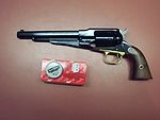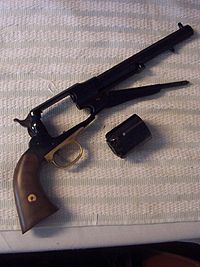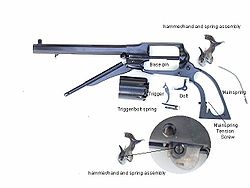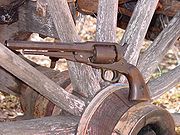
Remington Model 1858
Encyclopedia
The Remington New Model, was a percussion revolver
manufactured by Eliphalet Remington & Sons
in .36-(Navy) or .44-(Army) caliber revolver
used during the American Civil War
. Known as it was used primarily by Union soldiers, and widely favored over the standard issue Colt Army Model 1860
. It was expensive and those who could afford it, remarked due its durability and ability to quickly reload by switching to another pre-loaded cylinder.
It saw use in the American West
, both in its original percussion configuration and as a metallic cartridge conversion.
By the time of the Civil War, most percussion revolvers were fired with commercially made combustible cartridges, constructed of a powder envelope (usually paper cartridge
) glued to the base of a conical bullet. The treated envelope self-consumed upon firing. To load a combustible, a cartridge was dropped envelope first into each chamber and seated firmly with the loading lever, the process continuing until all six chambers were loaded. After all six chambers were loaded, placing a percussion cap on each of the six nipples at the rear of the cylinder readied the revolver for firing. The six chambers of a revolver cylinder could also be loaded one chamber at a time, by dropping in a powder charge from a flask, followed by seating either a round ball or conical bullet in each chamber, using the loading lever. To help prevent chain firing (also known as "cross-firing") of the black powder charge and to reduce black powder fouling, grease (such as tallow) was often put into each chamber on top of the loaded projectile. Combustible cartridge bullets were already pre-greased with beeswax, so the greasing step was unnecessary. The final loading step was capping as in the combustible cartridge loading method described earlier.
The combustible cartridge loading method sped up revolver loading considerably, simplified ammunition management, and became the loading method specified by the U.S. Ordnance Department just prior to the Civil War.
Remington percussion revolvers are very accurate, and capable of considerable power with muzzle velocities in the range of 550 to 1000+ feet-per-second, depending upon the charge loaded by the shooter. Combustible cartridge velocities averaged from 700 to 900 feet per second (274.3 m/s), depending on powder quality, charge and conical bullet weight. Combustibles were usually loaded with a special high performance sporting grade black powder, using the minimum charge required for a specified impact level, usually determined by pine penetration tests. The special powder and minimal charge reduced black powder fouling, allowing revolvers to be fired as much as possible before cleaning was necessary.
In 1868, Remington began offering cartridge conversions of the revolver in .46 Rimfire. Remington paid a royalty fee to Smith & Wesson, owners of the Rollin White
patent (#12,648, April 3, 1855) on bored-through revolver cylinders for metallic cartridge use. The Remington Army cartridge-conversions were the first large-caliber cartridge revolvers available, beating even Smith & Wesson's .44 American to market by nearly two years.
Remington percussion revolvers have appeared in notable movie scenes in films such as Pale Rider
, Gone with the Wind
, and The Good, the Bad and the Ugly
, as well as early episodes of Bonanza
. Easily identified by octagonal barrel, top strap frame, brass trigger guard and distinctive loading lever web, the streamlined Remington is easy to spot in movie and television scenes.

 The New Model owes its durability to its innovative “top-strap”, solid frame design, which fully encloses the cylinder. The design is stronger and less wear-prone than the Colt revolvers of the same era. The internal lock-work of the Remington is somewhat simpler in construction. While the Colt employs separate screws for the hand and trigger, those components share the same through-frame screw in the Remington design.
The New Model owes its durability to its innovative “top-strap”, solid frame design, which fully encloses the cylinder. The design is stronger and less wear-prone than the Colt revolvers of the same era. The internal lock-work of the Remington is somewhat simpler in construction. While the Colt employs separate screws for the hand and trigger, those components share the same through-frame screw in the Remington design.
The Remington-Beals revolver permitted easy cylinder removal allowing a quick reload with a spare pre-loaded cylinder, an advantage over other revolver designs of the time. The cylinder-swap procedure consisted of setting the hammer at half-cock, unlatching and lowering the loading lever halfway, sliding the cylinder pin forward to the stop, removing the cylinder from the frame's right side, and installing the spare cylinder from the right side. A slight rotation of the top of the cylinder towards the right side of the frame during cylinder removal or installation aids in slipping the cylinder ratchet past or under the hand. Centering the cylinder in the frame and sliding the cylinder pin back to seated position, secures the cylinder. Returning the loading lever arm to latched position readies the revolver for firing. The cylinder swap takes 12 seconds, or even less, depending on practice and skill.
For safety reasons, modern shooters using this technique should not have the percussion caps applied to the replacement cylinder until after it is installed in the revolver, in case it is accidentally dropped. The best solution is to avoid it by using properly fitting caps, grease or lube, nipples in good condition, and perhaps employing “cap guards,” short pieces of tubing that snug down over the sides of the cap and hold it in place, as well as seal it against moisture. Replacing the cap with safer firing pins also help. Securing the cylinder in a pocket or saddlebag is also important, cause a small bump can ignite all the unsecured bullets.
Another innovative feature, (first appearing in late 1862 in the 1861 Model production series) was safety slots milled between chambers on the cylinder. Some 19th century revolver designs lacked such safety features. Early Whitney revolvers, for example, were similar to the Remington, but lacked safety slots between cylinder chambers. It was possible to lower the Whitney hammer between cylinder chambers for safe carry. However, lacking the Remington milled slot, the Whitney cylinder could possibly slip and rotate, allowing the hammer to strike a loaded, capped chamber, causing an accidental discharge. The Remington milled slot positively secured the hammer between chambers for safe carry by preventing accidental cylinder rotation.
A prized possession of the Remington Arms Company is an original New Model Army with ivory grips once carried by William F. "Buffalo Bill" Cody. The historic revolver is on display with Cody's simple handwritten note, "It never failed me". Cody carried the revolver in original percussion form well into the cartridge era, and never converted it to cartridge use.

, Pietta, and Euroarms. The Euroarms and Uberti New Model Army replicas are nearly identical to originals, and most parts will interchange, based on 1959 through 2006 production examples. The Pietta New Model Army has a slightly enlarged grip area for more comfortable use by the larger hands of 21st century users. The Uberti and Pietta replicas are very popular in Cowboy Action Shooting as cartridge conversions or shooting black powder or modern replacements, just as the original Remington cartridge conversions were popular on the actual Western Frontier of the 1860s and 1870s. Several companies market drop-in "conversion" cylinders for both Uberti and Pietta replicas, enabling the firing of low-pressure cartridges without altering the revolver's frame. The cap & ball cylinder can be used interchangeably.
Modern metal conversion of the replica pistol are being produced by changeable cylinders. One of them is R&D Gun Shop that makes a cylinders that shoots .45 Colt cartridges and .38 Special in a replica 1858 Remington revolver. The new cylinder drops right in, replacing the cap and ball cylinder with no gunsmithing required. R&D has also converted replicas to fire smokeless powder
safely. Kirst Konverter also produces them in a different cylinder model that has a safety chamber called the Kirst Safety Cylinder. It only has 5 loading chambers but makes it a six shot cylinder because the star is designed to index to six separate positions.
The Remington-Beals design was 150 years old in 2008; replicas remain in use today in numbers far greater than original Remington production, a tribute to a rugged, simple design that remains practical and efficient in the 21st Century.
Revolver
A revolver is a repeating firearm that has a cylinder containing multiple chambers and at least one barrel for firing. The first revolver ever made was built by Elisha Collier in 1818. The percussion cap revolver was invented by Samuel Colt in 1836. This weapon became known as the Colt Paterson...
manufactured by Eliphalet Remington & Sons
Remington Arms
Remington Arms Company, Inc. was founded in 1816 by Eliphalet Remington in Ilion, New York, as E. Remington and Sons. It is the oldest company in the United States which still makes its original product, and is the oldest continuously operating manufacturer in North America. It is the only U.S....
in .36-(Navy) or .44-(Army) caliber revolver
Revolver
A revolver is a repeating firearm that has a cylinder containing multiple chambers and at least one barrel for firing. The first revolver ever made was built by Elisha Collier in 1818. The percussion cap revolver was invented by Samuel Colt in 1836. This weapon became known as the Colt Paterson...
used during the American Civil War
American Civil War
The American Civil War was a civil war fought in the United States of America. In response to the election of Abraham Lincoln as President of the United States, 11 southern slave states declared their secession from the United States and formed the Confederate States of America ; the other 25...
. Known as it was used primarily by Union soldiers, and widely favored over the standard issue Colt Army Model 1860
Colt Army Model 1860
The Colt Army Model 1860 is a muzzle-loaded cap & ball .44-caliber revolver used during the American Civil War, made by Colt's Manufacturing Company. It was used as a side arm by cavalry, infantry, artillery troops, and naval forces....
. It was expensive and those who could afford it, remarked due its durability and ability to quickly reload by switching to another pre-loaded cylinder.
It saw use in the American West
American Old West
The American Old West, or the Wild West, comprises the history, geography, people, lore, and cultural expression of life in the Western United States, most often referring to the latter half of the 19th century, between the American Civil War and the end of the century...
, both in its original percussion configuration and as a metallic cartridge conversion.
Overview
The Remington was a single-action, six-shot, percussion revolver produced by E. Remington & Sons, Ilion, N.Y., based on the Fordyce Beals patent of September 14, 1858 (Patent 21,478). The Remington Army revolver was large-framed, in .44 caliber, with an 8 inch barrel length. The Remington Navy revolver was slightly smaller framed than the Army, and in .36 caliber with an 7.375 inch [Beals Navy 7.5 inch] barrel length. There were three progressive models; the Remington-Beals Army & Navy (1860–1862), the 1861 Army & Navy (1862–1863), and the New Model Army & Navy (1863–1875). The three models are nearly identical in size and appearance. Subtle but noticeable differences in hammers, loading levers, and cylinders help identify each model. The 1861 Remington actually transitioned into New Model appearance by late 1862, slowly transforming throughout 1862, due to continual improvement suggestions from the U. S. Ordnance Department.By the time of the Civil War, most percussion revolvers were fired with commercially made combustible cartridges, constructed of a powder envelope (usually paper cartridge
Paper cartridge
Paper cartridge refers to one of various types of small arms ammunition used before the advent of the metallic cartridge. These cartridges consisted of a paper cylinder or cone containing the bullet, gunpowder, and, in some cases, a primer or a lubricating and anti-fouling agent...
) glued to the base of a conical bullet. The treated envelope self-consumed upon firing. To load a combustible, a cartridge was dropped envelope first into each chamber and seated firmly with the loading lever, the process continuing until all six chambers were loaded. After all six chambers were loaded, placing a percussion cap on each of the six nipples at the rear of the cylinder readied the revolver for firing. The six chambers of a revolver cylinder could also be loaded one chamber at a time, by dropping in a powder charge from a flask, followed by seating either a round ball or conical bullet in each chamber, using the loading lever. To help prevent chain firing (also known as "cross-firing") of the black powder charge and to reduce black powder fouling, grease (such as tallow) was often put into each chamber on top of the loaded projectile. Combustible cartridge bullets were already pre-greased with beeswax, so the greasing step was unnecessary. The final loading step was capping as in the combustible cartridge loading method described earlier.
The combustible cartridge loading method sped up revolver loading considerably, simplified ammunition management, and became the loading method specified by the U.S. Ordnance Department just prior to the Civil War.
Remington percussion revolvers are very accurate, and capable of considerable power with muzzle velocities in the range of 550 to 1000+ feet-per-second, depending upon the charge loaded by the shooter. Combustible cartridge velocities averaged from 700 to 900 feet per second (274.3 m/s), depending on powder quality, charge and conical bullet weight. Combustibles were usually loaded with a special high performance sporting grade black powder, using the minimum charge required for a specified impact level, usually determined by pine penetration tests. The special powder and minimal charge reduced black powder fouling, allowing revolvers to be fired as much as possible before cleaning was necessary.
In 1868, Remington began offering cartridge conversions of the revolver in .46 Rimfire. Remington paid a royalty fee to Smith & Wesson, owners of the Rollin White
Rollin White
Rollin White was an American gunsmith who invented a revolver with a bored-through cylinder which allowed metallic cartridges to be loaded from the rear.-Early life:...
patent (#12,648, April 3, 1855) on bored-through revolver cylinders for metallic cartridge use. The Remington Army cartridge-conversions were the first large-caliber cartridge revolvers available, beating even Smith & Wesson's .44 American to market by nearly two years.
Remington percussion revolvers have appeared in notable movie scenes in films such as Pale Rider
Pale Rider
Pale Rider is a 1985 American western film produced and directed by Clint Eastwood, who also stars in the lead role. This movie has plot similarities to the classic Western Shane , including in its final scene, as well as previous Eastwood films featuring his Man with No Name character and his 1973...
, Gone with the Wind
Gone with the Wind (film)
Gone with the Wind is a 1939 American historical epic film adapted from Margaret Mitchell's Pulitzer-winning 1936 novel of the same name. It was produced by David O. Selznick and directed by Victor Fleming from a screenplay by Sidney Howard...
, and The Good, the Bad and the Ugly
The Good, the Bad and the Ugly
The Good, the Bad and the Ugly is a 1966 Italian epic spaghetti western film directed by Sergio Leone, starring Clint Eastwood, Lee Van Cleef, and Eli Wallach in the title roles. The screenplay was written by Age & Scarpelli, Luciano Vincenzoni and Leone, based on a story by Vincenzoni and Leone...
, as well as early episodes of Bonanza
Bonanza
Bonanza is an American western television series that both ran on and was a production of NBC from September 12, 1959 to January 16, 1973. Lasting 14 seasons and 430 episodes, it ranks as the second longest running western series and still continues to air in syndication. It centers on the...
. Easily identified by octagonal barrel, top strap frame, brass trigger guard and distinctive loading lever web, the streamlined Remington is easy to spot in movie and television scenes.
Design


The Remington-Beals revolver permitted easy cylinder removal allowing a quick reload with a spare pre-loaded cylinder, an advantage over other revolver designs of the time. The cylinder-swap procedure consisted of setting the hammer at half-cock, unlatching and lowering the loading lever halfway, sliding the cylinder pin forward to the stop, removing the cylinder from the frame's right side, and installing the spare cylinder from the right side. A slight rotation of the top of the cylinder towards the right side of the frame during cylinder removal or installation aids in slipping the cylinder ratchet past or under the hand. Centering the cylinder in the frame and sliding the cylinder pin back to seated position, secures the cylinder. Returning the loading lever arm to latched position readies the revolver for firing. The cylinder swap takes 12 seconds, or even less, depending on practice and skill.
For safety reasons, modern shooters using this technique should not have the percussion caps applied to the replacement cylinder until after it is installed in the revolver, in case it is accidentally dropped. The best solution is to avoid it by using properly fitting caps, grease or lube, nipples in good condition, and perhaps employing “cap guards,” short pieces of tubing that snug down over the sides of the cap and hold it in place, as well as seal it against moisture. Replacing the cap with safer firing pins also help. Securing the cylinder in a pocket or saddlebag is also important, cause a small bump can ignite all the unsecured bullets.
Another innovative feature, (first appearing in late 1862 in the 1861 Model production series) was safety slots milled between chambers on the cylinder. Some 19th century revolver designs lacked such safety features. Early Whitney revolvers, for example, were similar to the Remington, but lacked safety slots between cylinder chambers. It was possible to lower the Whitney hammer between cylinder chambers for safe carry. However, lacking the Remington milled slot, the Whitney cylinder could possibly slip and rotate, allowing the hammer to strike a loaded, capped chamber, causing an accidental discharge. The Remington milled slot positively secured the hammer between chambers for safe carry by preventing accidental cylinder rotation.
A prized possession of the Remington Arms Company is an original New Model Army with ivory grips once carried by William F. "Buffalo Bill" Cody. The historic revolver is on display with Cody's simple handwritten note, "It never failed me". Cody carried the revolver in original percussion form well into the cartridge era, and never converted it to cartridge use.

Modern Use
The Remington-Beals design lives on today in the form of replicas from Italian manufacturers UbertiUberti
A. Uberti, Srl. is an Italian manufacturer of replica American firearms.Uberti produces high quality replicas of American percussion revolvers, cartridge revolvers, single-shot, and lever-action rifles....
, Pietta, and Euroarms. The Euroarms and Uberti New Model Army replicas are nearly identical to originals, and most parts will interchange, based on 1959 through 2006 production examples. The Pietta New Model Army has a slightly enlarged grip area for more comfortable use by the larger hands of 21st century users. The Uberti and Pietta replicas are very popular in Cowboy Action Shooting as cartridge conversions or shooting black powder or modern replacements, just as the original Remington cartridge conversions were popular on the actual Western Frontier of the 1860s and 1870s. Several companies market drop-in "conversion" cylinders for both Uberti and Pietta replicas, enabling the firing of low-pressure cartridges without altering the revolver's frame. The cap & ball cylinder can be used interchangeably.
Modern metal conversion of the replica pistol are being produced by changeable cylinders. One of them is R&D Gun Shop that makes a cylinders that shoots .45 Colt cartridges and .38 Special in a replica 1858 Remington revolver. The new cylinder drops right in, replacing the cap and ball cylinder with no gunsmithing required. R&D has also converted replicas to fire smokeless powder
Smokeless powder
Smokeless powder is the name given to a number of propellants used in firearms and artillery which produce negligible smoke when fired, unlike the older gunpowder which they replaced...
safely. Kirst Konverter also produces them in a different cylinder model that has a safety chamber called the Kirst Safety Cylinder. It only has 5 loading chambers but makes it a six shot cylinder because the star is designed to index to six separate positions.
The Remington-Beals design was 150 years old in 2008; replicas remain in use today in numbers far greater than original Remington production, a tribute to a rugged, simple design that remains practical and efficient in the 21st Century.
See also
- Colt 1851 Navy RevolverColt 1851 Navy RevolverThe Colt Revolving Belt Pistol of Naval Caliber , later known as the Colt 1851 Navy or Navy Revolver, is a cap and ball revolver. It was designed by Samuel Colt between 1847 and 1850. It remained in production until 1873, when revolvers using fixed metallic cartridges came into widespread use...
- Colt Army Model 1860Colt Army Model 1860The Colt Army Model 1860 is a muzzle-loaded cap & ball .44-caliber revolver used during the American Civil War, made by Colt's Manufacturing Company. It was used as a side arm by cavalry, infantry, artillery troops, and naval forces....
- Remington Model 1875Remington Model 1875Remington 1875 was a revolver by the Remington Arms. It was a based upon the successful Remington Model 1858 with both revolvers having the same size, appearance, and the removable cylinder magazine. The 1875 Remington single actions kept the solid frame and overall styling of the percussion models...
- Ruger Old ArmyRuger Old ArmyThe Ruger Old Army is a black-powder percussion revolver introduced in 1972 by the Sturm, Ruger company. The revolver is unusual in that, unlike most percussion revolvers on the market, it was not based on a historical design, but was a modification of Ruger's Blackhawk model, which was itself...

